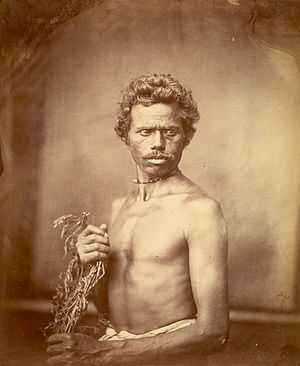Jalia Kaibarta

The Kaibarta (or Kaibartha), is a Hindu caste. The word Kaibarta means occupation through water (boating and fishing) traditionally found in Assam, western Orissa, eastern Bihar, West Bengal and Tripura. Kaibarthas are divided into two groups, Jaliya and Haliya. Jaliya Kaibarthas are categorized as a Scheduled Caste though the Mahishyas (Haliya Kaibarta) are not, though the Mahishya Samaj endeavored to instill pride in their agricultural roots, since they were the cultivators of the soil.[1]
Legendary origin
Writing in 1892, Herbert Hope Risley noted:
Concerning the etymology of the name Kaibartta there has been considerable difference of opinion. Some derive it from ka, water, and vartta, livelihood; but Lassen says* that the use of ka in this sense is extremely unusual in early Sanskrit, and that the true derivation is Kivarta, a corruption of Kimparta, meaning a person following a low or degrading occupation. This, he adds, would be in keeping with the pedigree assigned to the caste in Manu, where the Kaibarta, also known as Márgava or Dása, is said to have been begotten by a Nisháda father and an Ayogavi mother, and to subsist by his labour in boats. On the other hand, the Brahma-Yaívartta Purána gives the Kaibartta a Kshatriya father and a Vaisya mother, a far more distinguished parentage ; for the Ayogavi, being born from a Sudra father and a Vaisya mother, is classed as pratiloma, begotten against the hair, or in the inverse order of the precedence of the castes.[2]
History
Historians such as Jagabandhu Singh have referenced the Padma Purana and the Brahmavaibarta Purana to conclude that the Mahishyas and Kaivarttas (Kaibarttas) are the same caste. In general terms, a child born of a Kshatriya father and Vaishya mother is called a Kaivartta or Mahishya. If one takes the two terms to be synonymous, they are considered Kaivarttas. The Mahishyas formed a tight-knit social group; the movement to gain recognition as a caste separate from the Kaibarttas gained momentum in 1897, when the Mahishyas formed the Jati Nirdharani Samiti (Caste Assignment Forum). At the time, the Kaibarttas were divided into Jele Kaibarttas (fishermen), and Hele Kaibarttas (farmers).[3]
Matsya Kingdom
Matsya Kingdom was founded by fishermen community who later attained kingship. The Sanskrit word Matsya means fish. Satyavati, the wife of Kuru king Santanu was from this community. King Virata, a Matsya king, founded the kingdom of Virata. He was the father-in-law of Abhimanyu the son of Arjuna. The epic Mahabharata relates the founder of Matsya kingdom to the ruler of Chedi, viz Uparichara Vasu.
Fishing was the main occupation of the people who lived near river Sarasvati River. After the river dried up, they migrated to river Charmanwati now known as Chambal meaning fish in Dravidian languages. Krishna Dwaipayana Vyasa, was son of Satyavati who belonged to this fishermen community and yet was a Vedic scholar.
Mahabharata
The first Mastya king was mentioned to be the son of a king called Chedi Uparichara Vasu. He was a paurava, i.e., a king of the Puru dynasty. In addition to the five royal sons of this king, who had a son and a daughter born of a woman from the fishing community. The man child, in due course established the united Matsya Roya dynasty and founded the Matsya dynasty. The girl lived as a member of the fishing community of the banks of river Yamuna, in the kingdom of Kurus. The famous king Kuru Santanu's wife Satyavati was from this fishing community. The author of the Mahabharata, Krishna Vyasa Dwaipayana vis kings and kuru know vichitravirya chitrangada and the son of satyavati, pandavas and kauravas, the sons nie vichitravirya cough. A king called Sahaja Matsyas united and ruled the Chedi. Sagun Bhima became the cause of the destruction of his own race.
See also
References
- ↑ Venkatesh Salagrama; Food and Agriculture Organization of the United Nations (30 December 2006). Trends in Poverty and Livelihoods in Coastal Fishing Communities of Orissa State, India. Food & Agriculture Org. p. 80. ISBN 978-92-5-105566-3. Retrieved 18 April 2012.
- ↑ Sir Herbert Hope Risley (1892). The tribes and castes of Bengal: Ethnographic glossary. Printed at the Bengal secretariat press. p. 376. Retrieved 18 April 2012.
- ↑ Chakrabarty, Bidyut (1997). Local Politics and Indian Nationalism: Midnapur (1919-1944). New Delhi: Manohar. pp. 62–67.
